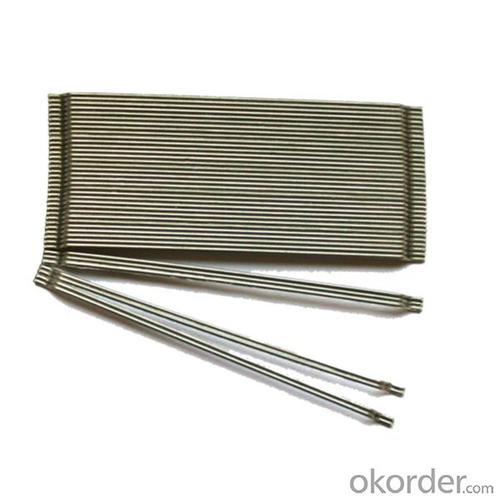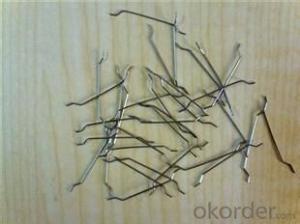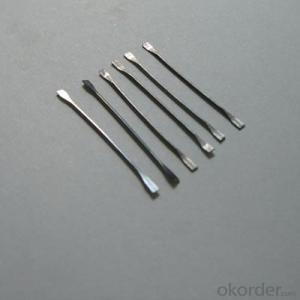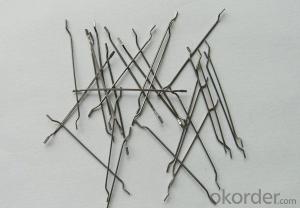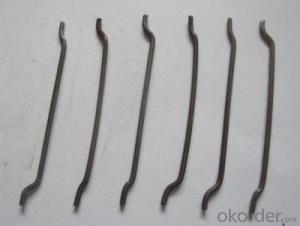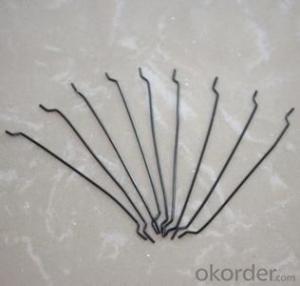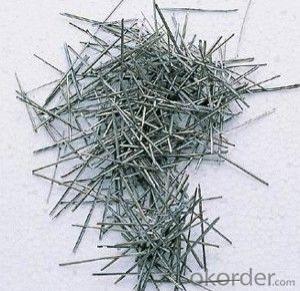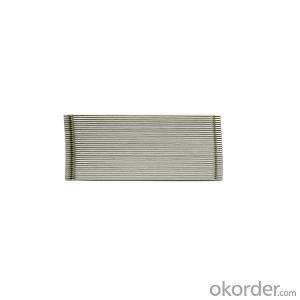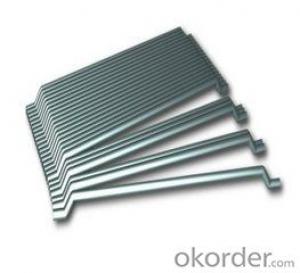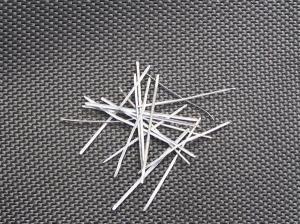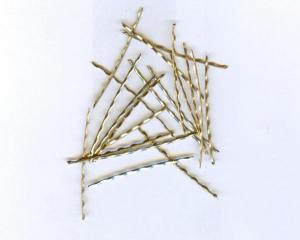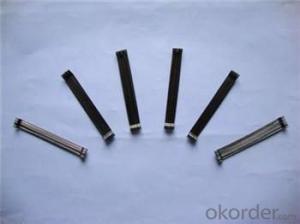Melt Extract Stainless Steel Fiber Cement Price Constructions Steel Fiber CNBM
- Loading Port:
- Tianjin
- Payment Terms:
- TT OR LC
- Min Order Qty:
- 1 m.t.
- Supply Capability:
- 600 m.t./month
OKorder Service Pledge
Quality Product, Order Online Tracking, Timely Delivery
OKorder Financial Service
Credit Rating, Credit Services, Credit Purchasing
You Might Also Like
Quick Details
Place of Origin: Tianjin, China (Mainland)
- Model Number: 0.55
Material: Steel
Production Process: Cold drawn
Fiber Lengh: 35
Type: 1
Compressive Strength: >1200MPa
Aspect ratio: 63
Standard: ASTM A820M-11
Section Shape: Circular
Application: Concrete Reinforcement
- Product Application: Industrial Floor
Packaging & Delivery
| Packaging Details: | 20 kg/Bag,50 bags/Pallet or 1,000kg/ Bulk Bag |
|---|---|
| Delivery Detail: | 1 Month |
Product Description
| Diameter | 0.55 | mm | 0.02 | in |
| Length | 35.00 | mm | 1.37 | in |
| Aspect Ratio | 64 | |||
| Tensile strength | 1200 MPa | |||
| Type | Cold drawn Steel Fiber | |||
| End | Hooked-end Steel Fiber | |||
| Glued/Loose | Glued Steel Fiber | |||
| Bending Angle | 45°(min.30°) | |||
| Usage & Performance | Floor:Trafficked areas and Industrial floors | |||
| Shotcrete :Slope stabilization and Final lining | ||||
| Precast concrete:Pipe and Railway sleepers | ||||
| Packing | Standard Export Pallet Packing | Bag Packing | 20 kg/Bag,50 bags/Pallet | |
| Bulk Packing | 1,000kg/ Bulk Bag | |||
| Loading Quantity | 20’GP | 20-25 Tonne/Tonnes | ||
| 40’GP | 25-27 Tonne/Tonnes | |||
| 40’HQ | 25-27 Tonne/Tonnes | |||
| MOQ | 1 kg for trial order | |||
| Supply Ability | 10,000 Tonne/Tonnes per Year | |||
| Payment Terms | T/T or L/C at sight | |||
| Delivery Time | Within 15 days after receiving deposit or original L/C at sight | |||
| Certification | ISO9001:2000, CE, | |||

| Product | Diameter | Length mm/in | Aspect Ratio | Type | Packing |
| G-6030 | 0.5 mm (0.0197 in) | 30 mm (1.1811 in) | 60 | Glued | 20 kg/Bag, or 1,000kg/ Bulk Bag |
| G-6535 | 0.55 mm (0.0217 in) | 35 mm (1.3780 in) | 65 | Glued | 20 kg/Bag, or 1,000kg/ Bulk Bag |
| G-6035 | 0.6 mm (0.0236 in) | 35 mm (1.3780 in) | 60 | Glued | 20 kg/Bag, or 1,000kg/ Bulk Bag |
| G-8060 | 0.75 mm (0.0295 in) | 60 mm (2.3622 in) | 80 | Glued | 20 kg/Bag, 50 bags/Pallet |
| G-6060 | 0.9 mm (0.0354 in) | 60 mm (2.3622 in) | 60 | Glued | 20 kg/Bag, 50 bags/Pallet |
| G-6030 | 0.5 mm (0.0197 in) | 30 mm (1.1811 in) | 60 | Loose | 20 kg/Bag, or 1,000kg/ Bulk Bag |
| G-6535 | 0.55 mm (0.0217 in) | 35 mm (1.3780 in) | 65 | Loose | 20 kg/Bag, or 1,000kg/ Bulk Bag |
| G-6035 | 0.6 mm (0.0236 in) | 35 mm (1.3780 in) | 60 | Loose | 20 kg/Bag, or 1,000kg/ Bulk Bag |
| G-8060 | 0.75 mm (0.0295 in) | 60 mm (2.3622 in) | 80 | Loose | 20 kg/Bag, 50 bags/Pallet |
| G-6060 | 0.9 mm (0.0354 in) | 60 mm (2.3622 in) | 60 | Loose | 20 kg/Bag, 50 bags/Pallet |
- Q: What is the optimal fiber volume fraction for melt extract stainless steel fiber in concrete?
- The optimal fiber volume fraction for melt extract stainless steel fiber in concrete typically ranges between 0.5% to 2% by volume, depending on the specific application and desired performance properties.
- Q: Can melt extract stainless steel fiber be used in highway pavements?
- Highway pavements can benefit from the use of melt extract stainless steel fiber. These fibers are renowned for their robustness and endurance, making them ideal for enduring heavy traffic and harsh environmental conditions. When incorporated into concrete or asphalt mixtures, stainless steel fibers enhance the overall performance of the pavement by bolstering its crack resistance, flexural strength, and fatigue resistance. This, in turn, prolongs the lifespan of the pavement and reduces the need for frequent repairs and maintenance. Furthermore, the corrosion-resistant qualities of stainless steel fibers ensure that the highway pavement remains structurally sound and intact as time passes. Therefore, incorporating melt extract stainless steel fiber into highway pavements is a viable solution for augmenting their durability and longevity.
- Q: What is the effect of melt extract stainless steel fiber on the drying time of concrete?
- The effect of melt extract stainless steel fiber on the drying time of concrete is primarily to decrease it. Stainless steel fibers, when added to concrete mixes, enhance the overall strength and durability of the concrete. These fibers act as reinforcement, providing extra tensile strength and crack resistance to the concrete. When it comes to drying time, the addition of melt extract stainless steel fibers can significantly shorten the time it takes for the concrete to dry and cure. This is because the fibers help to control and reduce the amount of shrinkage that occurs during the drying process. Shrinkage is a common issue in concrete, where the material tends to contract as it dries. This shrinkage can lead to cracks and other forms of damage in the concrete. However, the use of stainless steel fibers helps to minimize shrinkage and control cracking, ultimately reducing the drying time. The presence of these fibers also improves the overall performance of the concrete by increasing its resistance to various factors such as temperature changes, chemical attacks, and impact loads. This enhanced durability further contributes to a faster drying time, as the concrete is less susceptible to damage or degradation. In summary, the addition of melt extract stainless steel fiber to concrete can effectively decrease the drying time by controlling shrinkage and enhancing the overall strength and durability of the material. This results in a more efficient and reliable construction process, reducing the time required for the concrete to dry and cure.
- Q: What is the effect of melt extract stainless steel fiber on the permeability of asphalt mixtures?
- By incorporating melt extract stainless steel fiber into asphalt mixtures, a notable reduction in permeability can be achieved. When stainless steel fibers are introduced into the asphalt mixture, they establish a three-dimensional network within the asphalt matrix. This network serves to enhance the cohesion and strength of the asphalt mixture. The stainless steel fibers function as reinforcement, forming a barrier that limits the movement of water or other fluids through the asphalt mixture. Consequently, the permeability of the mixture is diminished, rendering it more resistant to water damage and enhancing its overall durability. Furthermore, the inclusion of stainless steel fibers aids in preventing the formation of cracks and minimizing the propagation of existing cracks within the asphalt mixture. This further bolsters the performance and lifespan of the asphalt pavement. In summary, the introduction of melt extract stainless steel fiber into asphalt mixtures yields a positive impact on permeability, reducing it and elevating the overall durability and performance of the asphalt pavement.
- Q: What is the effect of melt extract stainless steel fiber on the shrinkage and cracking of concrete?
- The primary way in which melt extract stainless steel fiber affects the shrinkage and cracking of concrete is by improving its overall tensile and flexural strength. When added to concrete, these fibers act as reinforcement, thereby reducing the instances of shrinkage and cracking. The drying process in concrete leads to shrinkage, which can result in cracks. However, the addition of melt extract stainless steel fibers helps enhance the concrete's tensile strength, thereby decreasing the likelihood of shrinkage cracks. These fibers create a network within the concrete, evenly distributing forces and stresses, which in turn mitigates the potential for cracking due to shrinkage. Furthermore, melt extract stainless steel fibers can enhance the concrete's resistance to cracking caused by external factors, such as temperature changes, heavy loads, or structural movements. By reinforcing the concrete, these fibers increase its ability to withstand bending and tensile forces, ultimately minimizing the occurrence of cracks. Moreover, the inclusion of melt extract stainless steel fibers improves the durability and longevity of concrete structures. By reducing shrinkage and cracking, these fibers contribute to the overall integrity and stability of the concrete, ensuring it can withstand various environmental and load conditions for an extended period. In conclusion, adding melt extract stainless steel fiber to concrete positively impacts shrinkage and cracking by improving its tensile strength, reducing the occurrence of shrinkage-related cracks, and enhancing its resistance to external forces. Ultimately, this results in more durable and long-lasting concrete structures.
- Q: What is the effect of melt extract stainless steel fiber on the modulus of rigidity of concrete?
- Concrete's modulus of rigidity is generally improved by the addition of melt extract stainless steel fibers. These fibers reinforce the concrete matrix, enhancing its overall performance and mechanical properties. The modulus of rigidity, or shear modulus, measures a material's stiffness and ability to resist deformation under shear stress. By incorporating stainless steel fibers, the modulus of rigidity is increased, resulting in a more rigid and durable concrete structure. Stainless steel fibers act as reinforcement within the concrete, providing additional strength and improving its tensile strength and crack resistance. This reinforcement prevents cracks from propagating and enhances the concrete's ability to withstand external loads and stresses. Furthermore, the inclusion of melt extract stainless steel fibers enhances the flexural strength of the concrete, enabling it to withstand bending forces without failure. This contributes to the overall rigidity of the concrete structure. The stainless steel fibers also help to evenly distribute applied loads throughout the concrete, reducing localized stress concentrations. This leads to a more uniform distribution of forces, ultimately enhancing the modulus of rigidity. In conclusion, the addition of melt extract stainless steel fibers has a positive impact on the modulus of rigidity of concrete, resulting in a stronger and more durable material. These improved mechanical properties make it suitable for various applications requiring high-performance concrete, such as infrastructure projects, industrial flooring, and seismic-resistant structures.
- Q: Is melt extract stainless steel fiber corrosion resistant?
- Yes, melt extract stainless steel fiber is corrosion resistant.
- Q: Can melt extract stainless steel fiber be used in parking lot pavements?
- Yes, melt extract stainless steel fiber can be used in parking lot pavements. Stainless steel fibers are commonly used as reinforcement in concrete to improve its strength, durability, and resistance to cracking. In parking lot pavements, which are subject to heavy loads and frequent traffic, the use of stainless steel fibers can help enhance the overall performance and longevity of the pavement. The fibers act as a reinforcement, distributing the stresses and preventing the formation and propagation of cracks. This can help reduce maintenance needs and increase the lifespan of the pavement, making it a cost-effective choice for parking lot construction.
- Q: Can melt extract stainless steel fiber improve the resistance of concrete to fire?
- Certainly, the incorporation of melt extract stainless steel fiber into concrete has the ability to enhance its fire resistance. Renowned for their elevated melting point, resistance to corrosion, and exceptional heat conductivity, stainless steel fibers are an optimal choice for bolstering the fire resistance of concrete. Upon their addition to concrete, these fibers establish a three-dimensional reinforcement network, effectively preventing the occurrence of cracks and spalling during exposure to fire. Furthermore, the stainless steel fibers serve as a heat sink, proficiently absorbing and dissipating heat, thus significantly impeding the rise in temperature within the concrete and consequently augmenting its fire resistance. Moreover, these fibers fortify the concrete's overall strength and durability, rendering it more resilient to fire and extending its structural integrity even under extreme temperatures. Consequently, the inclusion of melt extract stainless steel fiber in concrete unquestionably improves its resistance to fire.
- Q: Can melt extract stainless steel fiber replace traditional reinforcement in concrete structures?
- Stainless steel fibers extracted through the melt process can serve as an alternative to conventional reinforcement in concrete structures. These fibers possess various advantages compared to traditional reinforcement, including enhanced strength and durability. During the concrete mixing process, these fibers are evenly dispersed throughout the entire structure. Employing stainless steel fibers can effectively reduce or even eliminate the necessity for customary reinforcement methods like steel bars or mesh. This can result in significant cost savings, as the installation of steel bars or mesh can be both time-consuming and expensive. Moreover, stainless steel fibers exhibit superior crack control capabilities, as they proficiently distribute and confine cracks that may occur in the concrete. Consequently, this can improve the overall performance and lifespan of the structure. Furthermore, stainless steel fibers are resistant to corrosion, which represents a noteworthy advantage over traditional reinforcement. Over time, steel bars or mesh can corrode, leading to structural deterioration. By utilizing stainless steel fibers, the risk of damage caused by corrosion is greatly diminished. Nevertheless, it is crucial to consider that the use of stainless steel fibers as a substitute for traditional reinforcement should be evaluated on a case-by-case basis. Factors such as the structure's type, size, loading conditions, and desired design life must be taken into account. Consulting structural engineers and adhering to proper design guidelines and codes is imperative to ensure the successful utilization of stainless steel fibers as reinforcement in concrete structures.
Send your message to us
Melt Extract Stainless Steel Fiber Cement Price Constructions Steel Fiber CNBM
- Loading Port:
- Tianjin
- Payment Terms:
- TT OR LC
- Min Order Qty:
- 1 m.t.
- Supply Capability:
- 600 m.t./month
OKorder Service Pledge
Quality Product, Order Online Tracking, Timely Delivery
OKorder Financial Service
Credit Rating, Credit Services, Credit Purchasing
Similar products
Hot products
Hot Searches
Related keywords


